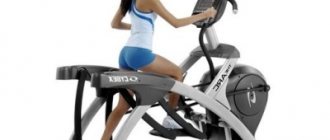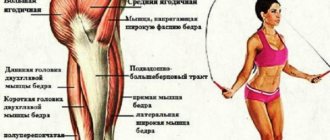First, let's figure out why we actually burn calories when we walk. No, it's not about speed or stride length! When you take the first step, you transfer your body weight to your forward leg. At the same time, the height of your center of gravity from the ground decreases - naturally, because your legs are apart, which means that the distance in a straight line upward becomes smaller. When you step with your other foot, you have to raise your center of gravity (at the moment when your feet are together). And this is where the main consumption of calories occurs - to overcome the force of gravity! Yes, yes, everything is the same as lifting a barbell, only you lift your own body. This is the moment when calories are consumed, the main energy of the step is spent on this.
How to calculate calorie consumption when walking?
As we explained above, your calorie consumption per kilometer depends on how many kilograms you lift with each step (that is, your body weight and height). Calorie consumption per kilometer does not depend on speed as such. However, energy consumption per minute or hour is directly related to speed. After all, at a higher speed, you will take more steps per minute and cover that same kilometer faster.
To calculate energy expenditure when walking, the following formula is usually used:
Energy consumption in kcal in 1 minute = (0.035 * your body weight) + (walking speed * 2 / your height) * 0.029 * your body weight
To get the cost per workout, all this must be multiplied by the walking time.
To avoid complex calculations, you can use a simplified option: every 2000 steps = 100 kcal .
Types of squats
Squats can be performed both in the gym and at home. It is not necessary to use additional equipment, since your own weight can be enough to lose weight.
The most popular type of this exercise is classic squats, which do not require special skills. The distribution of the load is determined by the depth of the squat. The positioning of the legs is also important, according to which the exercises are divided into several types. For example, plie and sumo squats are considered extremely effective for pumping up the gluteal muscles.
Many people are also interested in how many calories are burned during squats, known as partials. It is believed that the amount is greater than with deep squats. This type of exercise can be classified as cardio-strength, since it involves an active pace and makes it possible to work muscles that are not involved in a deep squat. Therefore, experts often advise performing partial and frequently repeated squats to increase calorie consumption.
The averages refer to how many calories squats without weights burn. As for weighted squats, it is believed that they burn 1.5-2 times more calories depending on their weight, body mass and again tempo.
Many ladies are afraid to squat with weights, believing that this will make their legs too pumped up, like a man’s. In fact, it is generally difficult for women to gain a lot of weight due to their natural characteristics, and small weights will not make you masculine. They will help you burn excess fat more effectively, make your legs sculpted and slender, and your buttocks toned and attractive. Therefore, you can safely use dumbbells, weights, expanders, barbells, as well as special exercise equipment in fitness clubs.
How many calories are burned by walking every day?
We all walk for a certain amount of time and at different speeds. Without counting the number of steps, energy consumption cannot be determined, so you need to use at least a basic pedometer, smartphone application or fitness bracelet. Smart devices can count calories themselves. Or use our table.
| 1000 steps | 50 kcal |
| 4000 steps | 200 kcal |
| 5000 steps | 250 kcal |
| 7000 steps | 350 kcal |
| 8000 steps | 400 kcal |
| 9000 steps | 450 kcal |
| 10000 steps | 500 kcal |
| 15000 steps | 750 kcal |
Of course, all this is somewhat arbitrary. After all, the height to which you lift your weight while walking also depends on how you walk: on a treadmill, along the street, up a hill. The surface and direction change the length of the step, respectively, its frequency, and the degree of bending of the legs.
Contraindications
- leg and joint injuries;
- severe scoliosis;
- severe varicose veins;
- arterial hypertension;
- heart failure and other pathologies.
Along with walking up the stairs, it is recommended to review your diet, focusing on protein and fiber, give up bad habits, and observe a work-rest schedule.
How many calories are spent walking in different conditions?
The easiest option is a treadmill. Since it rotates under you, you can hardly move your leg forward, which means you can minimally lower and raise your center of gravity.
“You will burn more calories if you walk outside,” says candidate master of sports PRO-expert Sportmaster PRO Daniil Lobakin. — On a treadmill there is no pushing force of the foot from the surface, due to which you can also burn calories. Additional load on the street can be caused by uneven terrain - rises. Nordic walking is more effective than regular walking because it works the arms and shoulder girdle. Due to the fact that while walking you also work with poles, you make more movements. During normal walking there is no such additional energy expenditure.”
How many calories does walking 1.5 km or 10 km burn?
As we have already explained, it all depends on your weight and number of steps. Typically, the step length is 50-70 cm (the taller the person, the longer the step will be). Thus, you will definitely burn 100 kcal per 1 km.
The 1 km distance is good because it can be found everywhere - on the way to school, work, or when going to the grocery store. That is, you can go through it several times a day without particularly noticing or getting tired.
The 5 km distance requires at least an hour of walking and a fairly brisk pace. After all, the average pedestrian speed is only 3-4 km/h. On average, such a walk will burn about 400 kcal.
Walking 10 km in one go is possible for well-physically trained people. At an average walking pace, you will spend about 3 hours on it and may feel quite exhausted. The result is up to 800 kcal, after which every muscle will be felt!
How to increase calorie expenditure while walking?
The easiest option is to walk more or faster to increase your step count. But there is another burden.
“You can hang weights on your legs or take a backpack with them,” suggests Daniil Lobakin. “Any weight gain will make exercise more difficult and create the conditions for greater caloric energy expenditure.” With weights, everything is individual. If a muscular man weighing about 90 kg is going to train, you can even choose two-kilogram weights. Girls are better off starting with 0.5 kg.
Also consider how long you will be walking with weights and where. “If you go uphill, half a kilo will be enough,” says Daniil Lobakin. - There are smaller weights - 250 g. If you walk on the plain for about half an hour, you can use kilogram ones. Everything here is very individual.” When choosing a weight, we need to take into account that we will not be walking for 2-3 minutes; according to experience, the average walking time is an hour and a half. There is no upper limit, since this is not an intense run, you can even walk all day, focusing on how you feel.
Correct walking technique
To maximize the benefits of walking, watch your body position.
- Maintain correct posture: do not lower your head, look 5-10 m ahead, do not slouch.
- Bend your elbows, as if running, and use them to set the amplitude of your step.
- Tighten your abdominal muscles, tighten your buttocks slightly.
- Walk, rolling your feet from heel to toe.
- Lightly emphasize the toe-off of the ground in the last phase of the step using the ankle joint.
Sometimes beginners try to master the technique of race walking. “Race walking is a rather technically complex sport, and it is not easy to master,” explains Daniil Lobakin. - World record - an athlete walked 21 kilometers in 1 hour 28 minutes, I run this distance slower. If you want to take up race walking, it is better to work with a trainer. The main subtlety of the race walking technique is that the arms must work together with the legs. People often get confused during training. In addition, race walking should not switch to running - in running there is a flight phase, and here there must be a constant point of support.”
Why exactly 10,000 per day?
Have you ever wondered why exactly 10,000 steps a day? Where did this figure come from, what is its scientific basis? Usually, articles simply state “that’s what scientists say” and that’s it, there are no further clarifications.
And in vain, otherwise people would know that this recommendation appeared completely by accident in 1964. Yoshiro Hatano invented the world's first electronic pedometer, and called his unique device “man-po-kei”, which literally translates from Japanese as “thousand step sensor”.
Why exactly 10,000? There is no clear answer; most likely, it’s just a successful and very working marketing ploy. The pedometer has become popular despite the fact that there is no evidence of the health benefits of ten thousand steps, says Professor David Bassett, director of kinesiology, recreation and sport research at the University of Tennessee.
Overall, pedometers are a great way to stay motivated. Many people speak extremely positively about them and say that this simple gadget helps them think about movement and lifestyle every day.
“You see some pathetic figure of 100 steps and you understand that you need to walk for at least 15 minutes. And then the excitement begins, you want to go further and better all the time” - here is a real review from one of the users.
In this regard, we completely agree with the users - a sedentary lifestyle does more harm than diabetes and smoking (you can read the details at the link). Therefore, it is worth purchasing this device, especially since it can even be ordered on AliExpress.
For example, here is the original Xiaomi mi Band 4 Smart , which recognizes and calculates your activity and calorie expenditure in 6 sports (cycling, free training, running, swimming, treadmill, walking, swimming).
Photo from a real person from reviews of
the product.
Also inside there is a stopwatch, a smart alarm clock (will wake you up at the biologically best time for you), a timer, and a reminder of events. The screen is covered with glass, not plastic, the bracelet holds the battery perfectly, charges quickly, and naturally is not afraid of contact with water. The colors are also stylish, not just banal black.
But let's return to our topic. How many steps do you really need to go through? Do scientists have an answer to this question?
A research team at Kyushu Health and Welfare University began investigating the potential benefits of following the 10,000 steps per day guideline. They concluded that on average Japanese people take between 3,500 and 5,000 steps per day, and that if these people increased their daily steps to 10,000, they could reduce their risk of coronary heart disease.
It sounds worthy and interesting, but again - why is everyone hooked on ten thousand? Why didn't you choose 15 or 9?
Even the World Health Organization, the American Heart Foundation and the US Department of Health and Human Services have adopted 10,000 steps as a recommendation for daily activity, although the validity of this number has been questioned.
The fact is that all the studies that are conducted on this topic are based on the principle described above: they compare people who took 10,000 steps a day with those who did much less, for example, 3,000 or 5,000, and then measure the calories burned, blood blood pressure and glucose levels.
It’s not surprising that those who were more active showed better results, this is logical. But why not compare this group with those who walk 8, 11, 15 or even 20 thousand steps daily?
“This number continues to strengthen because of the way research is conducted,” says Professor Catherine Tudor-Locke of the Center for Personalized Health Monitoring at the University of Massachusetts Amherst.
“YES, a study may find that 10,000 helps you lose weight more than 5,000, and then the media sees it and says “you should walk exactly 10,000 steps, that's what the scientists said,” but that could be because the study only tested these two numbers. This is not a test for 8,000, for example, or 12,000.”
Some studies examining the protective nature of exercise against chronic diseases, ranging from heart disease to stroke and various forms of cancer such as breast and reproductive cancers, show that between 6,000 and 8,000 steps is the bare minimum for health.
Scientists who tried to calculate the exact number of steps that equate to public health guidelines, which is about 30 minutes of moderate exercise a day, found that we should aim for a minimum of 7,500 steps.
This kind of activity is the norm and, according to experts from the EU, reduces the risk of cardiovascular diseases, diabetes and even cancer by 30-40% .
Today, WHO makes the following recommendations on the necessary minimum of movements to maintain healthy heart muscle and blood vessels for adults aged 18 to 64 years:
- 150 minutes of moderate intensity exercise per week (22 minutes per day - please note, the load should be continuous, i.e. 20 minutes at once, and not 4 times 5 and not 150 minutes in one day);
- or 75 minutes of intense exercise per week (10 minutes per day);
- You can also combine both types of load.
Experts from Kalmar University (Sweden) recommend taking 12,000 steps a day for men under 50 years of age and for women under 40 years of age. Men over 50 and women over 40 are recommended to walk 11,000 steps, then this figure decreases with age.
How to walk correctly for health and weight loss?
Walking is available for many health restrictions, so it is not surprising that it is so popular among fans of a healthy lifestyle.
“Walking is usually done for weight loss and cardiovascular training,” says Daniil Lobakin. — Beginners and people with excess weight and age walk just in the right pulse zone, about 130-145 beats per minute. The main thing in walking is the work of the hands, especially if a person walks with Scandinavian poles. The left leg goes - the right hand goes, alternating, you need to focus on this.”
If you decide to try Nordic walking, the main thing is to use poles specifically for it, and not for trekking. They are very similar, but trekking poles have a different grip, which interferes with Nordic walking.
And, of course, don’t forget about proper nutrition and calorie restriction - without this you won’t be able to lose weight even with the most intense workouts. Good walk!
Adviсe
- Before you start training, you need to warm up and warm up your muscles to avoid injury and damage.
- Shoes for training should be durable and comfortable, with practical non-slip soles.
- Outdoor activities will bring double benefits.
- It is not recommended to rest between ascent and descent.
- For pregnant women and older people, the recommendation is to hold on to the railing to avoid tripping and falling.
- After the first serious workout, your legs ache for a couple of days; this is a normal reaction of the body.
- For men and those who want to lose weight (regardless of gender), walking with weights is recommended.
If you experience knee pain while walking that does not go away even after you stop exercising, you should consult a doctor and postpone training. The situation is similar with a crunch in the knees: a physiological crunch is not dangerous, but you need to make sure that this is not a pathology










